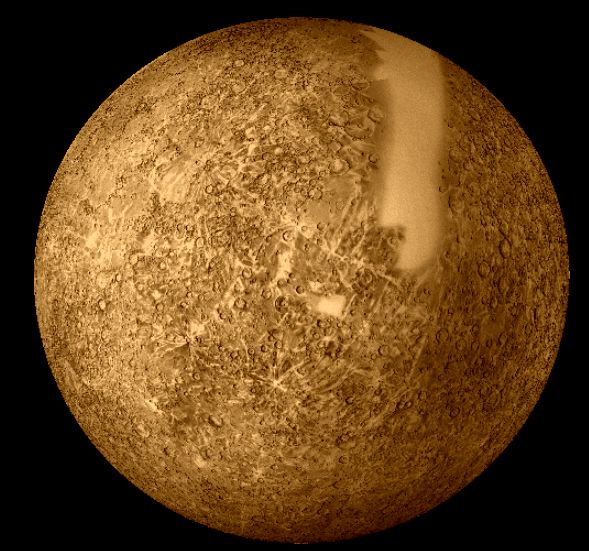[/caption]Mercury, the planet closest to the Sun, is a study in extremes and offers many surprises. The extremes of the planet have made it an understudied body in our Solar System, though the MESSENGER mission is trying to change that as you are reading this article.
In addition to being the planet closest to the Sun, Mercury is also the smallest by mass. If you ignore the former planet Pluto, it is also the smallest by surface area, as well. The planet has the most eccentric orbit: at perihelion it is 46,001,200 km from the Sun and at aphelion it is 69,816,900 km. The planet’s short orbital period(87.969 Earth days) and slight axial tilt combine to make the day on Mercury(116 Earth days) longer than the year.
The average temperature on the planet is 442.5°K. Because of the planet’s thin atmosphere there is a wide temperature range, 100°K to 700°K. The temperature at the equator can be as much as 300°K more than the temperature at the poles. Despite its proximity to our central star, the poles of the planet are thought to have water ice hidden within impact craters. Claims for water ice are substantiated by observations by the 70 m Goldstone telescope and the Very Large Array. There are areas of very high radar reflection at the pole areas so, since water is highly reflective of radar, astronomers believe that water ice is the most likely cause of this reflection.
Due to its size and average temperatures, the planet’s gravity can not retain a significant atmosphere over a long period. It does have a negligible surface-bounded exosphere that is dominated by hydrogen, helium, oxygen, sodium, calcium, and potassium. Atoms are continuously being lost and replenished from this exosphere. Hydrogen and helium atoms are thought to derive from the solar wind that buffets the planet. These elements diffuse into Mercury’s magnetosphere before escaping back into space. Radioactive decay within the crust is a source of helium, sodium, and potassium.
Mercury has been explored by two mission: Mariner 10 and MESSENGER. Mariner 10 was able to map 40-45% of Mercury’s surface through more than 2,800 photos. It revealed a more or less moon-like surface, a slight atmosphere, a magnetic field, and a large iron rich core. MESSENGER was launched in August of 2004. After a 31/2 year flight, it made its first flyby in January 2008 and arrived in orbit on March 18, 2011. So far, the probe has discovered large amounts of water in the exosphere, evidence of past volcanic activity, and evidence of a liquid planetary core.
As the MESSENGER mission continues, the closest planet to the Sun should continue to reveal more surprises for the scientists at NASA. It appears a new age of discovery has begun for Mercury.
We have an extensive section just on Mercury on Universe Today. And did you know there’s a spacecraft visiting Mercury called MESSENGER? You can read news about this mission here.
Here’s a link to NASA’s Solar System Exploration Guide on Mercury.
We have recorded an episode of Astronomy Cast just about the Sun called The Sun, Spots and All.
References:
Wikipedia: Mercury
NASA Solar System
NASA: Messenger Mission


How long is a day on mercury ,116 days or 58 days.It says 2 different number